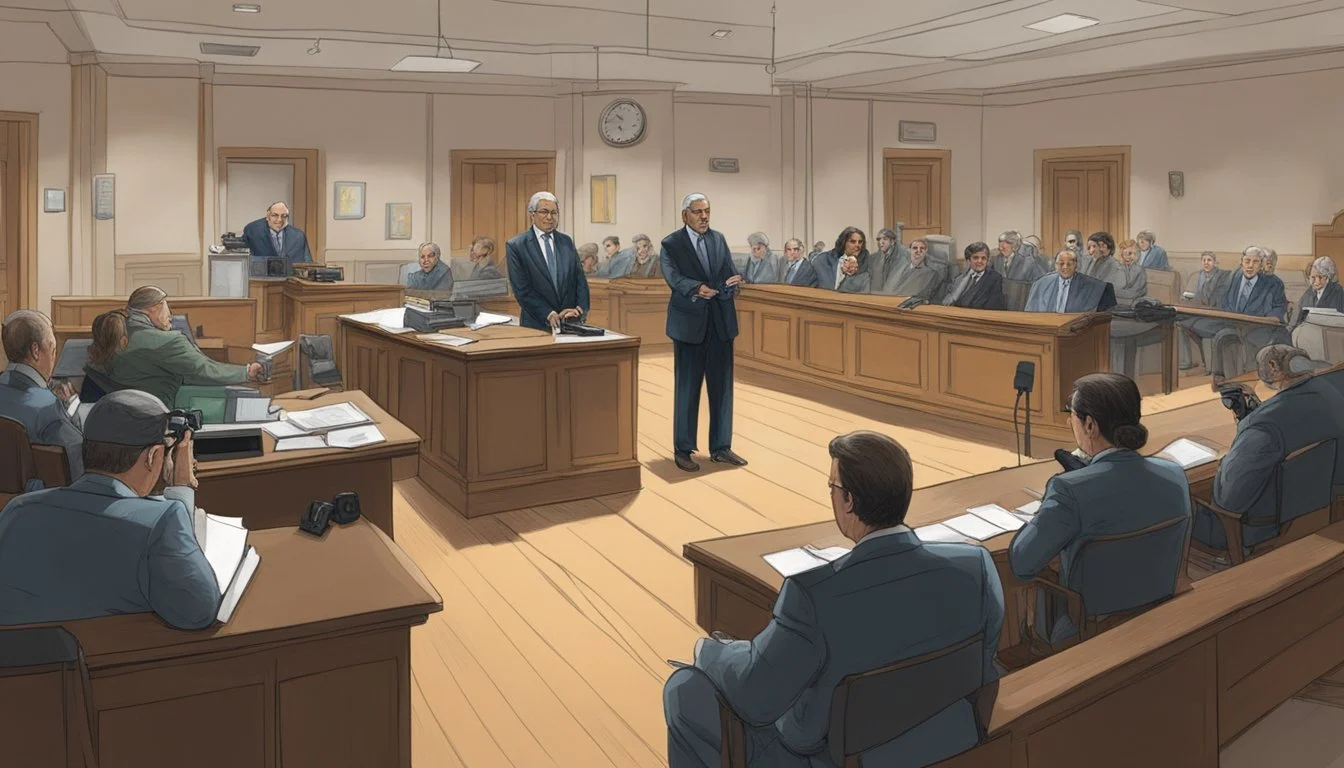Lethal Injection: Orville Lynn Majors and the Hospital Murders
Serial Killer Nurse Convicted
Orville Lynn Majors, a licensed practical nurse, committed a series of chilling murders at Vermillion County Hospital in Clinton, Indiana during the mid-1990s. His method of choice was lethal injection, using heart-stopping drugs to end the lives of his unsuspecting patients. Majors was convicted of six murders, though investigators suspected he may have been responsible for many more deaths during his employment at the hospital.
The case of Orville Lynn Majors shocked the small Indiana community and garnered national attention. His actions earned him the sinister moniker "Angel of Death" as he preyed on vulnerable patients under his care. The murders went undetected for years until an investigation uncovered the disturbing pattern of deaths associated with Majors' shifts.
In 1999, Majors faced justice in a high-profile trial that lasted five weeks and featured testimony from dozens of witnesses, including medical professionals. The jury found him guilty on six counts of first-degree murder. The court sentenced Majors to 360 years in prison, effectively ensuring he would spend the rest of his life behind bars for his heinous crimes.
Background of Orville Lynn Majors
Orville Lynn Majors began his nursing career in Indiana before gaining notoriety for patient deaths at Vermillion County Hospital. His early life and employment history provide context for understanding the events that led to his conviction as a serial killer.
Early Life and Career
Orville Lynn Majors was born on April 24, 1961. He pursued a career in healthcare, becoming a licensed practical nurse (LPN) in Indiana. LPNs typically complete a one-year training program and are responsible for basic patient care under the supervision of registered nurses and doctors.
Majors worked at various healthcare facilities in Indiana before his employment at Vermillion County Hospital. His early career appeared unremarkable, with no known incidents foreshadowing his later crimes.
Employment at Vermillion County Hospital
Majors began working at Vermillion County Hospital in Clinton, Indiana in 1993. The small rural hospital served a tight-knit community. During his tenure, the facility experienced an alarming spike in patient deaths.
Between 1993 and 1995, the hospital's death rate increased significantly. Staff and families grew suspicious of the unusually high mortality rate, particularly when Majors was on duty. Investigations revealed that many patients died unexpectedly after Majors administered injections.
Law enforcement eventually uncovered evidence suggesting Majors had been injecting patients with heart-stopping drugs. This discovery led to his arrest and subsequent trial for multiple murders.
The Rise in Hospital Deaths
Vermillion County Hospital experienced an alarming spike in patient deaths between 1993 and 1995. The sudden increase raised concerns among staff and triggered an investigation into the unexplained fatalities.
Statistical Anomalies
The death rate at Vermillion County Hospital surged dramatically during this period. Statistics showed a significant increase in patient mortality, particularly among elderly patients and those in the Intensive Care Unit.
The hospital's average death rate jumped from 26 deaths per year to 120 in 1994. This 400% increase was unprecedented and far exceeded normal fluctuations.
Notably, the spike in deaths correlated strongly with the work shifts of one specific employee - Orville Lynn Majors.
Beginning of Suspicion
Hospital staff began noticing patterns in the unexpected deaths. Patients who were stable or improving would suddenly deteriorate and die when Majors was on duty.
Nurses reported seeing Majors enter patient rooms shortly before codes were called. Some witnessed him giving unauthorized injections.
The high number of deaths during Majors' shifts raised red flags:
130 deaths during his shifts in a 22-month period
Only 81 deaths occurred during shifts without him
Death rate on his shifts was 43% vs 6% on other shifts
These stark disparities prompted hospital administrators to launch an internal review, eventually leading to a full criminal investigation.
Investigation and Arrest
The investigation into the suspicious deaths at Vermillion County Hospital led to the arrest of Orville Lynn Majors. Authorities meticulously gathered evidence and coordinated efforts to build a case against the licensed practical nurse.
Collection of Evidence
Indiana State Police launched a thorough investigation into the unusually high death rate at the hospital. They reviewed patient records and conducted interviews with staff members. Investigators discovered a pattern of deaths occurring during Majors' shifts.
Syringes and drugs became key pieces of evidence. Police found vials of potassium chloride and other medications in Majors' possession. Forensic analysis revealed traces of these substances in some of the deceased patients.
Autopsies were performed on exhumed bodies, providing crucial medical evidence. Toxicology reports indicated lethal levels of drugs in several victims.
Coordination with Authorities
The Indiana State Police worked closely with local law enforcement and prosecutors. They established a task force dedicated to the case.
Experts from various fields were consulted, including medical professionals and forensic specialists. Their input helped build a strong scientific foundation for the prosecution.
Authorities conducted extensive background checks on Majors. They uncovered inconsistencies in his employment history and qualifications.
In December 1997, police arrested Orville Lynn Majors. He was charged with multiple counts of murder based on the accumulated evidence.
Trial and Conviction
Orville Lynn Majors faced justice in a high-profile trial for the murders of patients at Vermillion County Hospital. The proceedings captivated public attention and culminated in a lengthy prison sentence.
Court Proceedings
The trial of Orville Lynn Majors began in the fall of 1999. Prosecutors presented a compelling case, calling 79 witnesses to testify. Among them were 23 doctors who provided expert testimony. The court heard evidence of Majors injecting patients with heart-stopping drugs, leading to their deaths.
Majors maintained his innocence throughout the trial. His defense team attempted to cast doubt on the prosecution's evidence and suggested alternative explanations for the patients' deaths. The trial lasted five weeks, with both sides presenting their arguments and evidence in detail.
Jury Deliberation
After hearing all the testimony and examining the evidence, the jury began their deliberations. They carefully weighed the facts presented during the trial. The jury found Orville Lynn Majors guilty on six counts of murder.
In November 1999, Judge Ernest Yelton sentenced Majors to 360 years in prison - 60 years for each murder conviction. The sentence effectively ensured Majors would spend the rest of his life behind bars. He was transferred to Indiana State Prison to serve his term.
The conviction of Majors brought a sense of closure to the families of the victims and the community affected by his crimes. It also highlighted the importance of vigilance and proper oversight in healthcare settings to prevent such tragic events from occurring in the future.
The Medical Perspective
The medical aspects of Orville Lynn Majors' case centered on lethal injections and expert analysis of patient deaths. Medications and drug levels played a crucial role in determining the cause and manner of the victims' deaths.
Role of Medications in Deaths
Majors allegedly used potassium chloride and epinephrine to induce fatal heart attacks in his victims. These heart-stopping drugs can cause rapid cardiac arrest when administered in high doses. Potassium chloride disrupts the heart's electrical activity, while epinephrine can trigger dangerous arrhythmias.
Investigators found abnormally high levels of these medications in some victims' bodies. This raised suspicions, as such concentrations were inconsistent with standard medical care. The presence of injection marks on victims further supported the theory of deliberate administration.
Expert Testimonies
Medical experts played a key role in analyzing the deaths. Pathologists examined tissue samples and toxicology reports to differentiate between natural causes and intentional poisoning. They noted patterns inconsistent with normal end-of-life scenarios.
Cardiologists explained how the drugs could induce fatal cardiac events. Pharmacologists testified about the lethal potential of the medications when misused. These expert opinions helped establish that the deaths were not due to natural causes like respiratory failure or typical heart attacks.
Forensic analysts also examined hospital records and medication logs. They identified discrepancies that suggested unauthorized drug access and administration by Majors.
The Aftermath
Orville Lynn Majors' conviction sent shockwaves through the community and legal system. The case had far-reaching consequences for the victims' families and led to significant legal repercussions.
Impact on Victims' Families
The families of Majors' victims experienced profound grief and trauma. Many struggled to come to terms with the betrayal of trust by a healthcare professional. Dorothea Hixon, whose mother was one of the victims, expressed relief at the verdict but noted the pain would never fully subside.
Some families sought closure through civil action. Several wrongful-death lawsuits were filed against the hospital, citing negligence in oversight and failure to investigate the suspicious deaths earlier.
The case prompted many to advocate for stricter background checks and monitoring of healthcare workers. Support groups formed to help affected families cope with their losses and navigate the legal processes that followed.
Legal Repercussions
Majors received a maximum sentence of 360 years in prison, effectively ensuring he would spend the rest of his life behind bars. The judge imposed consecutive 60-year terms for each of the six murder convictions.
The case led to changes in Indiana's healthcare regulations. Stricter protocols for reporting and investigating unexpected deaths in hospitals were implemented. The state also enhanced its oversight of licensed practical nurses.
Forensic experts conducted thorough autopsies on exhumed bodies, revealing traces of potassium chloride and epinephrine. This evidence proved crucial in securing the conviction and highlighted the importance of detailed post-mortem examinations in suspected medical murders.
Public Perception and Media Coverage
The Orville Lynn Majors case shocked the public and garnered extensive media attention. His actions at Vermillion County Hospital in Clinton, Indiana sparked fear and outrage in the community.
Media Portrayal
News outlets dubbed Majors the "Angel of Death," a moniker that emphasized the sinister nature of his crimes. This label contrasted sharply with his role as a nurse, traditionally seen as a caregiver. The media focused on the vulnerability of his elderly victims, highlighting the betrayal of trust.
Newspapers like The New York Times reported on Majors' "tender touch," juxtaposing his outward demeanor with his alleged actions. TV coverage often featured interviews with victims' families, intensifying public emotion.
Community Response
Clinton residents expressed disbelief and anger as the case unfolded. Many struggled to reconcile Majors' friendly persona with the accusations against him. Local gatherings and vigils were held to support the victims' families.
The hospital faced scrutiny, with some questioning how the deaths went unnoticed for so long. This led to discussions about patient safety and oversight in healthcare settings. The case eroded trust in medical institutions, particularly in small communities like Clinton.
Public opinion shifted as the trial progressed, with many calling for justice and stricter safeguards in hospitals. The community's response reflected a mix of fear, sorrow, and a desire for accountability.
Review of Hospital Procedures
The Orville Lynn Majors case led to significant changes in hospital protocols and oversight. These reforms aimed to enhance patient safety and prevent similar incidents in the future.
Internal Changes
Rural Indiana hospitals implemented stricter medication tracking systems. Nurses were required to document all drug administrations in detail. Suspicious deaths triggered immediate internal investigations.
Union Hospital in Clinton introduced random drug tests for staff. They also installed security cameras in medication storage areas. Nursing supervisors increased their rounds, especially during night shifts.
Many facilities adopted the "two-person rule" for accessing certain medications. This meant two staff members had to be present when retrieving potent drugs.
External Oversight
State regulators intensified their inspections of rural hospitals. They focused on medication management practices and patient mortality rates. The Indiana State Department of Health conducted surprise audits more frequently.
Licensing boards implemented more rigorous background checks for healthcare workers. They also mandated continuing education on ethics and patient safety.
Some hospitals formed partnerships with larger medical centers. This allowed for external review of unusual cases and access to specialized expertise.
Public reporting of hospital performance metrics became more common. This increased transparency helped rebuild trust in the healthcare system.




